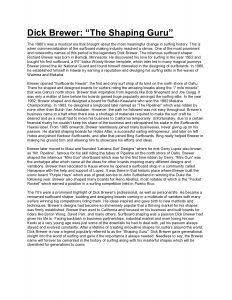Buzzy Trent model 1963 Elephant Gun surfboard shaped by the late Dick Brewer (1936-2022) in the early 2000s. The surfboard model of revered big wave surfing pioneer, Buzzy Trent (1929-2006). Gorgeous balsawood shape with redwood nose block, stringer, and stunning redwood fin. Signed “Shaped and Designed by Dick Brewer”. 11’6 elephant gun. Ride or display this remarkable big wave surfboard work of art.
If you have questions about this balsa Buzzy Trent model surfboard scroll down to leave a comment or call us toll-free at 1-800-210-6714
Buzzy Trent, called by many “The Godfather of big-wave surfing” was undeniably a legend and a pioneer of his field. He was born on May 13, 1929, under “Goodwin Murray Trent Jr” in San Diego, California. His family was wealthy- his mother’s family owned Parkinson’s Ranch, where Palomar Junior College now remains and his father was an engineer for a mining company. They raised Buzzy in Santa Monica, where he bodysurfed and began his surfing adventure at age 12 in Malibu. He enjoyed surfing but wasn’t a keen beachgoer. Buzzy had a great time boxing and thought of turning into a bullfighter. A star football player in high school, he earned a scholarship to the University of Southern California. Unfortunately, he broke his leg in a game against Ohio State. After the injury healed, he returned to surfing and got a job as a lifeguard in L.A. County. In 1950, after watching George Downing’s surf movies about surfing in Hawaii, he decided that he had to try it out himself. As a deckhand on a catamaran, his crew unofficially won the First Trans-Pacific Yacht race. He continued on the ocean liner as it operated throughout the Pacific before living in Hawaii.
Soon, the Hawaiian lifestyle won him over. Living in the true spirit of aloha, he never sold a used board. Instead, he would give his boards away to others without ever asking anything in return. Trent stayed in a Quonset hut at Makaha and spent his time diving, reading, but most importantly, riding the biggest waves possible. Makaha became his stage, with the charging of 20-foot+ waves. Trent formed relations with some of the biggest names in the surfing world. Bob Simmons offered him to ride his foam prototypes. George Downing, whose surfing as well as shaping Trent highly admired, became his long-time friend. Although he never thought of going pro, he trained regularly to conquer the power of the ocean. “Waves are not measured in feet or inches, they are measured in increments of fear” - these are the words only a pioneer of big-wave surfing could have said. We also note him as being the first to describe a big-wave surfboard as a “gun”. In 1957, he stood at the top of the big-wave frenzy, earning a heavy reputation among the most important individuals of the day. Others couldn’t match his style, no one could tame the waves like Buzzy Trent did. He became well known for his achievement of consistently charging mammoth-sized Makaha. Privately, he was married to a West Side girl named Viola and they had two children - Anna and Ivan, both connected to the surfing life. As Buzzy wasn’t a pro surfer he supported his family in other ways- first as a fireman, later as a construction worker for the company that built Ala Moana mall. Working there, he had an accident, when his colleague accidentally knocked him off the 14th floor of a building. Trent fell about 50 feet, then grabbed onto a 12th-floor girder and pulled himself back up to resume work. “He came home and talked about it real casual (…) just dust himself off and go surf.” - recalls his son, Ivan.
Although Buzzy said that surfing was just a hobby and there shouldn’t be such a thing as competitive surfing, the impact he had made in the surfing world is quite significant. He had ended his surfing career by 1973. “I went for this wave and backed off. I knew what was going to happen to me. It was nature’s way of protecting me.” - that’s how he allegedly explained the end of this chapter to his son. When he gave up surfing at the age of 47, he took up hang gliding to keep the endorphins pumping, and retired from the Dillingham Corporation in 1980. He passed away in his sleep in 2006, at Hale Ho Aloha nursing home in Honolulu. He was 77 years old.
